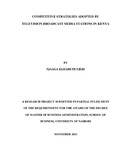| dc.contributor.author | Njaaga, Elizabeth N | |
| dc.date.accessioned | 2013-11-25T15:02:49Z | |
| dc.date.available | 2013-11-25T15:02:49Z | |
| dc.date.issued | 2013-11 | |
| dc.identifier.citation | Degree Of Master Of Business Administration | en |
| dc.identifier.uri | http://erepository.uonbi.ac.ke:8080/xmlui/handle/123456789/60171 | |
| dc.description | A research project submitted in the partial fulfillment of the requirement for the award Of Degree Of Master Of Business Administration, School Of Business, University Of Nairobi | en |
| dc.description.abstract | One of the challenges presented by a dynamic environment is increased competition.
Competition is indeed a very complex phenomenon that is manifested not only in other
industry players but also in form of customers, suppliers, potential entrants and substitute
products. It is therefore necessary for a firm to understand the underlying sources of
competitive pressure in its industry in order to formulate appropriate strategies to respond
to competitive forces. Competitive strategy specifies the distinctive approach which the
firm intends to use in order to succeed in each of the strategic business area. Competitive
strategy gives a company an advantage over its rival in attracting customers and
defending against competitive forces. The objectives of this study were to determine the
dimensions of competition faced by television media stations in Kenya and also establish
the competitive strategies that television media stations has adopted to cope with the
challenges of increased competition in the television broadcast media industry in Kenya.
The researcher used cross- sectional survey in the study. The target population of interest
in this study was the fully operational television channels in Kenya. There are currently
over 16 fully operational television channels in Kenya. The researcher applied
proportionate stratified sampling during data collection to select the managers from the
study population. Proportionate stratified sampling was appropriate since it identifies sub
groups in the population and in their proportions and selected from each subgroup a
sample. A sample size of 14 was targeted and data was collected using a questionnaire
that allowed for uniformity of responses of questions. Besides, secondary data was
collected from documentations from these companies. Data collected was processed
through computer software SPSS (Statistical Package for Social Studies) and presented in
the report in form of tables and graphs. The study found out that the competitive
strategies used by television media stations were cost leadership and differentiation. The
strategies according to the study findings have placed the companies in a favorable
position relative to the competition. These strategies have also made television media
stations to not only achieve high levels of efficiency and effectiveness, but to also gain
and sustain competitive advantage. The study also found out that the dimensions of
competition for television media stations were threats of new entrants, threat of
substitutes, power of suppliers, bargaining power of buyers and intensity of rivalry. | en |
| dc.language.iso | en | en |
| dc.publisher | University of Nairobi | en |
| dc.title | Competitive Strategies Adopted by Television Broadcast Media Stations in Kenya | en |
| dc.type | Thesis | en |
| local.publisher | School of Business | en |

